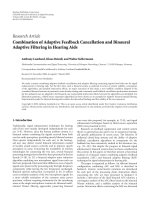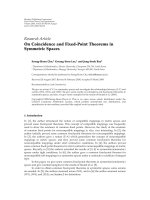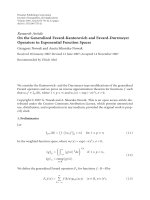Research and simulation fluid dynamic in solar greenhouse dryer
Bạn đang xem bản rút gọn của tài liệu. Xem và tải ngay bản đầy đủ của tài liệu tại đây (1.96 MB, 65 trang )
VIETNAM NATIONAL UNIVERSITY
HO CHI MINH CITY
HO CHI MINH CITY UNIVERSITY OF TECHNOLOGY
--------*-------
DUONG HOANG PHI YEN
RESEARCH AND SIMULATION FLUID DYNAMIC IN
SOLAR GREENHOUSE DRYER
Major: Chemical engineering
Code: 8520301
MASTER THESIS
HO CHI MINH CITY, January - 2022
THIS RESEARCH WAS CONDUCTED AT
HO CHI MINH CITY UNIVERSITY OF TECHNOLOGY
VNU- HCM
Supervisor: Dr. Tran Tan Viet
Reviewer 1: Assoc. Prof. Dr. Nguyen Tuan Anh
Reviewer 2: Assoc. Prof. Dr. Le Anh Kien
The master thesis was defended at Ho Chi Minh city University of Technology,
VNU-HCM, January 1st, 2022 (Online)
The members of Assessment Committee including:
1. Assoc. Prof. Dr. Nguyen Quang Long
- Chairman
2. Assoc. Prof. Dr. Nguyen Tuan Anh
- Reviewer 1
3. Assoc. Prof. Dr. Le Anh Kien
- Reviewer 2
4. Dr. Pham Thi Hong Phuong
- Committee
5. Dr. Pham Hoang Huy Phuoc Loi
- Secretary
Confirmation of the Assessment Committee Chairman and the Head of Faculty
after the thesis has been corrected (if any).
Assessment Committee Chairman
Assoc. Prof. Dr. Nguyen Quang Long
Dean of Chemical Engineering Faculty
Prof. Dr. Phan Thanh Son Nam
I
VIETNAM NATIONAL UNIVERSITY
HCM SOCIALIST REPUBLIC OF VIETNAM
HO CHI MINH CITY UNIVERSITY OF
Independence - Freedom - Happiness
TECHNOLOGY
MASTER THESIS MISSIONS
Date of Birth: 01/01/1996
Place of Birth: Tra Vinh
Major: Chemical engineering
Code: 8520301
I. THESIS TITLE:
RESEARCH AND SIMULATION FLUID DYNAMIC IN SOLAR GREENHOUSE DRYER
MISSIONS AND CONTENTS:
- Investigation of the impact of weather conditions on temperature and humidity
distribution inside SGHD by changing a suitable grid by ANSYS Fluent.
- Investigation of the influence of time on the temperature and humidity distribution
inside the SGHD.
II. DATE OF ASSIGNMENT: 22/02/2021
III. DATE OF COMPLETION: 05/12/2021
IV. SUPERVISORS:
Dr. Tran Tan Viet
SUPERVISORS
HEAD OF DEPARTMENT
Dr. Tran Tan Viet
Assoc. Prof. Dr. Le Thi Kim Phung
DEAN OF CHEMICAL ENGINEERING FACULTY
Prof. Dr. Phan Thanh Son Nam
II
ACKNOWLEDGEMENT
Each of us has a beautiful youth during my time at the Ho Chi Minh City University
of Technology, where youth and enthusiasm are imprinted. This university is my home,
where I can source knowledge to nurture my passion for learning. Also, it was the same
place that gave me great friends, teachers, and unforgettable memories.
First, I would like to express my gratitude and respect to my advisor Dr. Tran Tan
Viet. Thank you for your support, guidance, and encouragement throughout writing my
thesis. Thank you for creating the best environment for me to study and practice as a
solid fulcrum when facing difficulties. Thank you for your teachings when I stumble to
know that the past does not equal the future.
Besides, I would like to extend this thanks to my friends. Thank you to my best friends
(Tony, Bao, Nin, Luon, and Duong) who have always been with me throughout realizing
my passion.
Finally, my best sincere hank goes to my parents, who supported me with this project
within the limited time frame.
Ho Chi Minh City, 18th December 2021
Duong Hoang Phi Yen
III
ABSTRACT
This study investigates the internal conditions of the solar greenhouse dryer with drying
agricultural products. The operating conditions inside the solar greenhouse dryer were
analyzed by ANSYS Fluent software using mathematical models. Additionally, the
moist air outside changed according to the climatic conditions of the day. Specifically,
moist air enters the dryer through two front doors and exits through three exhaust fans
installed in the back, and the flow was considered unstable and tumultuous. Agricultural
products inside the solar greenhouse dryer were modeled as a porous material, and the
radiation was modeled according to the radiation model. The simulation results show
the distribution of temperature and humidity inside the solar drying greenhouse by the
influence of heat exchange, turbulent flow, and the process of removing moisture from
the drying material to the outside. The simulation results show that indoor drying
temperature ranges from 303.15 K to 323.1 K at each time from 7:00 AM to 6:00 PM.
The drying house reached its highest temperature at 2:00 PM. Variations of relative
humidity in GHSD are between 23.70% and 79.55%. The airflow velocity inside the
drying house is almost independent of time and varies based on location. In addition,
the numerical simulation for solar greenhouse dryer performance. The numerical
simulations compared the meshing strategies for the dryer and showed the effects on
both temperature distribution and relative humidity distribution of air inside the dryer.
Unstructured meshes were used in the numerical simulation employing hexahedral
meshing and tetrahedral meshing for mesh generation. The meshing strategies were
evaluated through 2 sizes of cells, i.e., 0.1 m and 0.05m. The results indicated that the
cell size has a stronger effect than the mesh type on the temperature profile and humidity
of the air inside the dryer. Thus, the results gave the engineers more options to select the
optimum meshing conditions and simulate the dryer.
IV
TĨM T T
Lu
s d ng ph n m m mơ ph
mô t phân b nhi
m v v n t c c a d ng không kh m bên trong nh s
t t i t nh An Giang
ng Tháp v i t ng m c tiêu khác nhau (các thông s kh
gian và s
ng c
ng m t tr i do
i nhi t, dòng ch y r
m i th
m t 7 gi
S
s
ng t
n 323,1 K t i
t nhi
cao nh t lúc 2 gi chi u.
i trong nhà s y là t
gió bên trong nhà s y h
ng c a quá trình
m t v t li u s y ra bên ngoài. K t
n 6 gi t i. Nhà s
ic
i theo th i
i). K t qu mô ph ng cho th y s phân b nhi t
m bên trong nhà kính s
qu mơ ph ng cho th y nhi
n 79,55%. V n t c lu ng
thu c vào th
i tùy theo v trí.
Ngồi ra, mô ph ng s cho hi u su t c a thi t b s y nhà kính b
Bên c
o sát s
nhi
và phân b
c
it
i khơng có
i l c di
i phù h
i t di n.
c c a ô, t c là 0,1 m
c ơ có
m c a khơng khí bên trong máy s
u ki
ng lên c phân b
i c a khơng khí bên trong. Các m
và 0,05m. K t qu ch ra r
nhi
ng m t tr i.
i cho nhà s y và cho th
c s d ng trong mô ph ng s s d
L a ch
,
ng nhà s y.
ng m
i lo
t qu
n
hi
c
V
DECLARATION
I hereby declare that the thesis has been composed by myself and that the work
has not to be submitted for any other degree or professional qualification. I confirm that
the work submitted is my own, except where work formed part of jointly authored
publications has been included. My contribution and those of the other authors to this
work have been explicitly indicated below. Finally, I confirm that appropriate credit has
been given within this thesis where reference has been made to the work of others.
Part of the work presented in this thesis was my publication, which was
previously published in Scientific Reports, Chemical Engineering Transaction, and the
IOP conference journal.
Chemical Engineering Transaction as Three-Dimetional of Simulation of The
The Author
Duong Hoang Phi Yen
VI
TABLE OF CONTENTS
MASTER THESIS MISSIONS ....................................................................................... I
ACKNOWLEDGEMENT .............................................................................................. II
ABSTRACT ..................................................................................................................III
TÓM T T..................................................................................................................... IV
DECLARATION ............................................................................................................ V
TABLE OF CONTENTS ............................................................................................. VI
LIST OF FIGURES ...................................................................................................... IX
LIST OF TABLES ....................................................................................................... XI
1. PREFACE ....................................................................................................................1
1.1. Rationale ................................................................................................................1
1.2. Research aims and Objectives ...............................................................................3
1.3. Outline of thesis .....................................................................................................3
2. LITERATURE REVIEW ............................................................................................4
2.1. Solar drying process overview...............................................................................4
2.1.1. Solar drying ......................................................................................................4
2.1.2. Classification of drying methods using solar energy .......................................5
2.1.3. Various shapes of the SGHD ...........................................................................7
2.2. Introduction to computational fluid dynamic (CFD) simulation ...........................8
2.2.1. ANSYS Fluent .................................................................................................9
2.2.2. Working principle of ANSYS CFD .................................................................9
3. MATHEMATICAL MODELS .................................................................................12
3.1. Conservation equations [20] ................................................................................12
3.1.1. Mass conservation:.........................................................................................12
3.1.2. Momentum conservation ...............................................................................12
VII
3.1.3. Energy conservation.......................................................................................13
3.1.4. Heat and mass balances in SGHD: ................................................................14
3.2. Viscous Model [20] .............................................................................................18
3.2.1. Standard k3.2.2. Realizable k-
........................................................................................18
......................................................................................19
3.3. Species model [16] ..............................................................................................21
3.3.1. Mass diffusion in turbulent flow ....................................................................21
3.3.2. Treatment of Species Transport in the Energy Equation ...............................22
3.4. Radiation model [20] ...........................................................................................22
4. SIMULATION OF SOLAR GREENHOUSE DRYER ............................................24
4.1. Bench-scale of solar greenhouse dryer ................................................................24
4.1.1. Geometry ........................................................................................................24
4.1.2. Geometrical discretization [20]......................................................................25
4.1.3. Physical properties and boundary conditions ................................................26
4.1.4. Simulation method and the operating conditions ..........................................27
5. RESULTS AND DISCUSSION................................................................................29
5.1. Profile temperature and relative humidity inside the SGHD ...............................29
5.1.1. The distribution of temperature .....................................................................30
5.1.2. The distribution of relative humidity .............................................................33
5.2. The sensitive mesh ...............................................................................................35
5.3. Mesh quality ........................................................................................................38
5.3.1. Influence of number of cells on the simulated results ...................................41
5.3.2. Influent of mesh type on the simulated results ..............................................43
6. CONCLUSION .........................................................................................................48
LIST OF PUBLICATION .............................................................................................49
VIII
REFERENCES ..............................................................................................................50
SHORT CURRICULUM VITAE .................................................................................52
IX
LIST OF FIGURES
Figure 1. Principle of heat collection of solar drying equipment [Héliantis: the principle]
.........................................................................................................................................4
Figure 2. Classification of solar drying methods [9, 10] .................................................5
Figure 3. The structure of SGHD ....................................................................................6
Figure 4. The structure of SGHD using the indirect method [9] .....................................7
Figure 5. Various shapes of the SGHD [13] ...................................................................8
Figure 6. The fluid region of the pipe flow is discretized into a finite set of control
volumes ..........................................................................................................................10
Figure 7. The whole process of CFD simulation stages [19] ........................................11
Figure 8. Distribution of some parameters in SGHD [21] ............................................15
Figure 9. The SGHD model designed by SpaceClaim ..................................................24
Figure 10. Simulation temperature profile inside the SGHD from 7:00 AM to 6:00 PM
.......................................................................................................................................29
Figure 11. Experimental temperature inside the SGHD from 7:00 AM to 6:00 PM ....30
Figure 12:Temperature distribution of moist air in the volume (a) at various locations
and (b) in the middle of the SGHD ...............................................................................31
Figure 13:Temperature distribution of moist air in the volume of the SGHD at various
times : (a): 8:00 AM; (b): 10:00 AM; (c): 12:00 PM; (d): 1:00 PM; (e): 2:00 PM; and
(f): 4:00 PM ...................................................................................................................32
Figure 14: Velocity vectors of the airflow inside the SGHD ........................................33
Figure 15:RH distribution of moist air in the volume of the SGHD at various time: (a):
8:00 AM; (b): 10:00 AM; (c): 12:00 PM; (d): 1:00 PM; (e): 2:00 PM; and (f): 4:00 PM
.......................................................................................................................................34
Figure 16: RH distribution of moist air in the volume of the SGHD at various locations
.......................................................................................................................................35
Figure 17. Mesh distribution of SGHD for different mesh grid types: (a) hexahedral
mesh H01, (b) hexahedral mesh H005, (c) tetrahedral mesh T01, and (d) tetrahedral
mesh T005 .....................................................................................................................38
X
Figure 18. The orthogonal quality mesh (a) hexahedral mesh H01, (b) tetrahedral mesh
T01, (c) hexahedral mesh H005 and (d) tetrahedral mesh T005. ..................................40
Figure 19. The skewness of mesh (a) hexahedral mesh H01, (b) tetrahedral mesh T01,
(c) hexahedral mesh H005 and (d) tetrahedral mesh T005. ..........................................41
Figure 20. The skewness and orthogonal mesh quality (2015 ANSYS, Inc.) ...............41
Figure 21. Temperature distribution and velocity of air inside SGHD at 10 AM for
different mesh grid sizes: (a) and (c): tetrahedral mesh T01, (b) and (d) tetrahedral mesh
T005 ...............................................................................................................................43
Figure 22. Comparison of the average temperature profiles (a) and the maximum
temperature profiles (b) computed using different tetrahedral meshes .........................43
Figure 23. Temperature distribution and the temperature volume rendering of air inside
SGHD at 10 AM using hexahedral mesh type, (a) and (c): hexahedral mesh H01, (b) and
(d): hexahedral mesh H005 ...........................................................................................45
Figure 24. Comparison of the average temperature profiles (a) and the maximum
temperature profiles (b) computed using hexahedral mesh type T01 and tetrahedral mesh
type H01 ........................................................................................................................45
Figure 25. Relative humidity distribution of air inside SGHD at 10 AM using tetrahedral
mesh type T01 (a) and hexahedral mesh H01 (b). ........................................................46
Figure 26. Comparison of the relative humidity computed using hexahedral mesh type
(H01) and tetrahedral mesh type (T01) .........................................................................47
XI
LIST OF TABLES
Table 1. The dimension of the SGHD ..........................................................................25
Table 2. Properties of the drying agent materials .........................................................26
Table 3. The properties of the solid material ................................................................26
Table 4. The boundary conditions of the SGHD ..........................................................27
Table 5. The operating condition of the SGHD ...........................................................28
Table 6. The type of mesh ............................................................................................36
1
1. PREFACE
1.1. Rationale
2
3
1.2. Research aims and Objectives
In this thesis, ANSYS Fluent is simulation software used to simulate the SGHD
with 6mx8mx3.5m. This type of drying house has been placed in An Giang and Dong
Thap province with two categories:
Firstly, the primary objective of this work was to simulate the influence of time on
the temperature and humidity distribution inside the SGHD. The daily meteorological
aspects were considered in the simulation result, and the model was validated through
experimental field solar drying data and representing an advance for the accurate
prediction of the drying. This contributed to the design of a more efficient process.
Secondly, this research simulates the impact of weather conditions on temperature
and humidity distribution inside SGHD by changing a suitable grid by ANSYS Fluent.
Two types of mesh, including tetrahedral and hexahedral meshing, were conducted in
this research, and the number of cells generating a mesh is various values, dependent on
the size of the cell.
1.3. Outline of thesis
This work is split into 5 chapters: Firstly, A Preface and Literature review in
Chapters 1 and 2 with the theoretical portion is discussed. Third, the mathematical
models part of the thesis is described in Chapter 3. And then, the results and discussion
in Chapter 4 and conclusions in Chapter 5.
4
2. LITERATURE REVIEW
2.1. Solar drying process overview
2.1.1. Solar drying
The greenhouse effect can explain collecting heat from the sun of solar drying
equipment. This is the accumulation of radiant energy of the sun under glass or a certain
layer of gas according to the principle: "The monochromatic clarity of a glass or a layer
1 illustrates the solar dryer's heat recovery principle.
Figure 1. Principle of heat collection of solar drying equipment [Héliantis: the
principle]
5
2.1.2. Classification of drying methods using solar energy
Figure 2. Classification of solar drying methods [9, 10]
6
2.1.2.1. The direct drying method
The structure of the forced convection solar drying equipment is shown in Figure
3.
Figure 3. The structure of SGHD
Part of the solar radiation reaching the dome will be reflected into the air, and the
rest will pass into the interior of the chamber. On the other hand, part of the radiation is
reflected from the material's surface. The surface of the material absorbs the rest. By
absorbing solar radiation, the product temperature will rise, and it will begin to emit
radiation of long wavelengths, and these waves cannot escape the environment outside
the drying house due to the obstruction of the roof. As a result, the temperature of the
product inside the chamber will become higher. In addition, the dome also has another
function as insulation to reduce heat loss to the surrounding environment, facilitating
the increase of the drying chamber temperature. However, losses due to convection and
evaporation still occur inside the chamber. The moisture content is carried away by air
entering the chamber from below and exiting through the opening in the drying house.
The goal of a solar dryer is to provide the drying material with more heat than is
available under ambient conditions, which should be sufficient to increase the vapor
7
pressure of the moisture in the dried material and significantly reduce the relative
humidity of the drying air. Thus, increasing the moisture carrying capacity [2].
2.1.2.2. The indirect drying method
The indirect solar energy drying device has 02 parts: the heat collector and the
drying chamber [3]. Products when drying will not be exposed to direct sunlight because
they are placed in the drying chamber. If the hot air is led into the chamber by natural
convection, it is called a natural convection solar drying device. If hot air is blown in, it
is called forced convection. With a blower and ducting unit, the forced convection solar
dryer can direct hot air to any location for multiple purposes. Forced airflow accelerates
water vapor diffusion and shortens drying time [4]. The structure of the forced
convection solar drying equipment is shown in Figure 4.
Figure 4. The structure of SGHD using the indirect method [9]
2.1.3. Various shapes of the SGHD
The structure of the solar drying house is one of the important factors determining
the receipt of radiation from the sun through location and orientation. Several studies on
the structure of the drying house show that the irregular shape receives higher solar
radiation, and the Quonset shape reports the lowest solar radiation in the east-west
direction. Besides, some irregular shaped drying houses will receive the highest amount
8
of solar radiation in the east and west and the lowest in the north and south directions.
Unstructured drying houses have lower energy and heat requirements when compared
to other shaped greenhouses. It had been reported that the uneven shape greenhouse
dryer had lower energy and heating requirements in comparison with other shapes of
greenhouse dryer [11]. The effect of assorted shapes (even, uneven, single, vinery,
modified arch, Quonset), and orientation on the performances of the solar greenhouse
dryers. It was observed that one span-shaped dryer with east-west orientation reported
maximum solar incident radiation when put next with others. It had also been reported
that the radiation loss could be minimized by employing a brick wall at the sun-facing
wall of the greenhouse dryer. Some researchers compared five different shapes (even,
uneven, vinery, semi-circular, elliptical) and orientation with varying the ground area
(50 to 400 m2), from which they observed that the elliptical shape performed better than
other shapes [12]. The varied shapes of the solar greenhouse dryer are shown in Figure
5.
Figure 5. Various shapes of the SGHD [13]
2.2. Introduction to computational fluid dynamic (CFD) simulation
CFD or Computational Fluid Dynamic is a fluid mechanic branch that analyzes the
fluid flow, heat transfer, mass transfer, and associate chemical reactions. CFD uses the
9
numerical method and data structure to solve the set governing mathematical equations
such as conservations of momentum, mass, energy, species, or the effect on body forces.
CFD is now utilized to research and solve engineering problems in various industries,
including aerodynamics of aircraft and vehicles, hydrodynamics of ships, power plants,
turbomachinery, electrical and electronic engineering, chemical process engineering, etc.
CFD aid brings a significant potential in saving time in optimization and process design
and reduces the cost compared to experimentation and data acquisition. [14]
2.2.1. ANSYS Fluent
ANSYS FLUENT software was introduced by Ansys Inc. company in 2006 to
apply for computational fluid dynamics. This software supplies all the needed tools for
equipment design, optimization, and installation troubleshooting. The flexibility of this
technology shows insight into how the product performs in the real world before an
innovated sample is generated. The CFD packages provide solvers that precisely model
the behavior of a wide variety of flows that engineers regularly face
from Newtonian
to non-Newtonian, from single phase to multi-phase, and from subsonic to hypersonic.
Each solver for rapid simulation time is highly stable, well tested, validated, and
optimized. Tested time and part of a single environment, both precision and speed are
provided by highly efficient solvers. [15]
2.2.2. Working principle of ANSYS CFD
The finite volume method is the main principle of this solver. This method is
applied to solve the partial differential equations by the numerical method. The domain
of the problem is divided into a finite set control of volumes. Then, the general
conservation equations are solved numerically by the divergence theorem. This method
was also simply formulated to permit the unstructured grid. [16]
10
Figure 6. The fluid region of the pipe flow is discretized into a finite set of control
volumes
The important problem of fluid dynamics algorithms is to describe the kinematic
properties of fluids. To solve this problem, it is necessary to know the physical
properties of fluids using the descriptive tools of fluid mechanics. Then, mathematical
equations (Navier-Stokes equations) can describe these physical properties, which is the
governing equation of CFD [17].
The Navier-Stokes equation is general, a system of differential equations, and can
be solved analytically. However, the problem is usually solved with the help of a
computer through numerical methods. According to the numerical method, this system
of equations will be converted to discrete form by methods such as finite difference,
finite element, or finite volume method. Accordingly, it is necessary to divide the entire
survey domain into several small parts and run the program to calculate iteratively. The
programming languages used to build the usual solution method are Fortran and C.
Finally when receiving simulation results, it is possible to compare and analyze these
results with other experiments or real experience data. If the results are not reliable
enough to solve the problem, we must repeat the process until we find a satisfactory
solution [18]. This is the whole process of CFD. This process is depicted in Figure 7.
11
Figure 7. The whole process of CFD simulation stages [19]
12
3. MATHEMATICAL MODELS
3.1. Conservation equations [20]
The mathematical terms are presented by the governing equations of fluid flow
based on the following conservation law of physics:
3.1.1. Mass conservation:
The mass balance of the fluid elements is presented by:
Rate of increase of mass in fluid element = Net rate of flow of mass into the fluid
element (1)
Where:
The rate of increase of mass in the fluid element is
and the second term of the equation is:
The equation (1) is rearranged by divided by element volume
, then shown
in the form of:
or
This equation is unsteady and used for a 3D continuity equation at an
incompressible fluid point.
3.1.2. Momentum conservation
Rate of increase of momentum of fluid-particle = Sum of forces on the fluid
particle (2)
The left-hand side source term for all dimensions of the coordinate per unit volume
of a fluid particle is supplied by:
,
and
. The forces consist of surface forces
and body forces. Surface forces include pressure, viscous forces and gravity forces and









